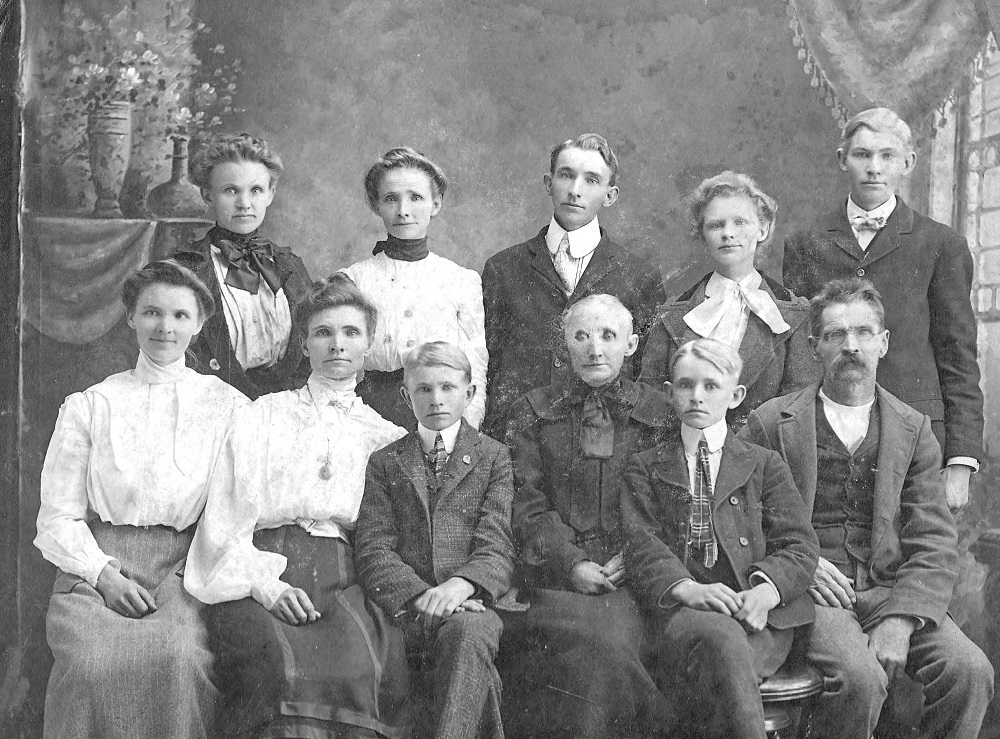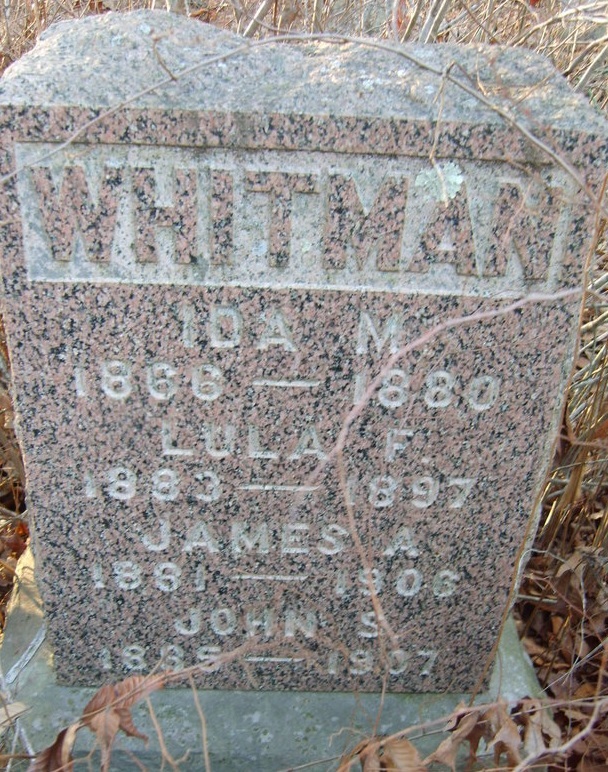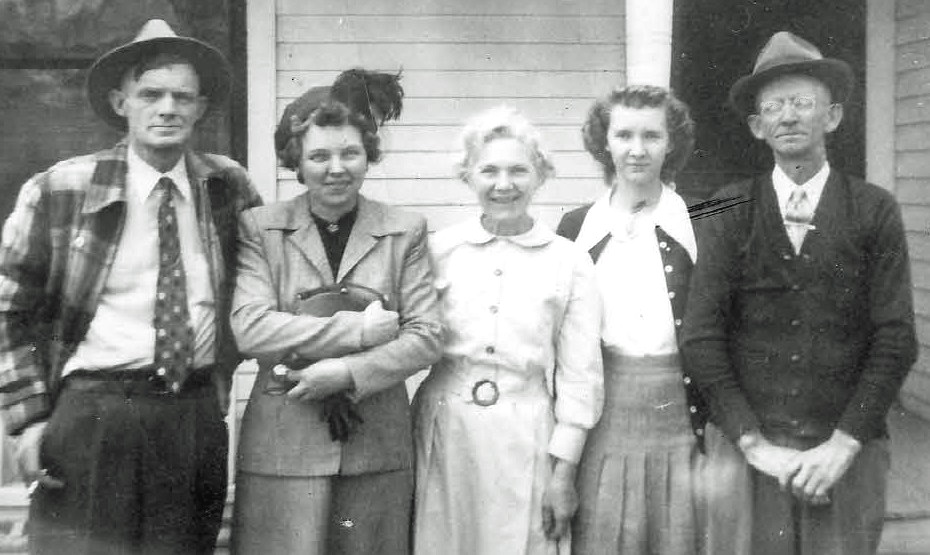Scroll up for the only
extant photo of
the Sam Whitman
family, and for
the sections on
Family culture
and
The scourge of TB.
Scroll down for
the sections on
Lincoln ancestry
and
Whitman family tree.
| How Aunt Ollie Whitman introduced me to Evangelical Protestantism
By 1957, my siblings had all grown up and moved away. At the age of 13, I was the only child still at home with our parents on the farm. Such was the context in which the Whitman line of my ancestry, until then of much less consequence to me than the Westhues, Conran, or Oser lines, suddenly became a lifeline, with lasting impact on my adolescent identity.
Since even before I started school at St. Mary’s, hay fever had bothered me every August and September. This year it morphed into asthma over the Labor Day weekend, just before I was to begin Grade 8. I couldn’t sleep and gasped for breath from dusk to dawn one particular night, probably September 1 or 2. Mom and Dad were frantic by morning, fearing I would die if they did not act fast.
The two doctors in town routinely made house calls, but I do not recall seeing either one that day. I do remember Father William Drimped, the pastor of St. Mary’s, arriving in his cassock and biretta, symbols of his authority in our rural Catholic community. I was lying on the living room couch, wheezing and coughing. Father Drimped advised taking me to St. Joseph’s Hospital in Boonville, half an hour away, for a thorough check-up. He had more faith in doctors than my parents did.
Lodged in my mother’s mind was a nonmedical remedy for respiratory ailments that harked back to her Whitman heritage: escape quickly from Missouri’s suffocating heat and humidity to the thinner, cooler, drier air of Colorado. By early afternoon that day, my parents had decided Mom should take me immediately to Colorado Springs, while Dad stayed home to mind the farm.
Glasgow still had one slow westward train a day, a doodlebug, departing the depot about 3:30 PM. It would get us to Kansas City Union Station in three hours. There we could catch the Missouri Pacific streamliner, the Colorado Eagle, at 9:00 PM, arriving in Colorado Springs at 8:00 AM the next day. I heard Mom on the phone to the depot agent, a family friend. “Don’t let the train leave without us,” she said. Dad drove fast into town. When we pulled up to the depot, the doodlebug was there waiting.
My two sisters, Dolores and Margie, both then living in Kansas City, came to Union Station and sat with Mom and me during our layover. Excitement for this adventure seemed by itself to have cured me. I had taken only a couple of short train trips in my life. Mom asked me repeatedly how I was feeling. I said I felt fine. As things turned out, the asthma never recurred, neither that year nor any year since.
My parents had decided I should remain in Colorado that fall until a hard freeze had killed ragweed and other plant allergens in Missouri, typically near the end of October. The question was where I would live once Mom returned to Dad on the farm.
Mom’s brother Doug and his wife Louise said I was welcome to stay with them on weekends. They had moved to the Springs for Doug’s health in 1942. Doug had recently built a modest chalet of ponderosa pine deep in the woods 20 miles west of the Springs up Ute Pass. They could not, however, keep me during the week. They both commuted daily to jobs in the Springs, and there was no school near their home.
To the rescue came Aunt Ollie Whitman, then 64 years old. She and her husband Bill (Bertha Whitman’s brother, youngest child of Sam and Missouri Whitman) had moved to the Springs with their three children in 1935, probably for reasons of health. Uncle Bill had been a storekeeper. By 1957, the children had grown up and moved away, and Uncle Bill had died in 1956. Aunt Ollie, now a widow, lived by herself in an old frame house with a front porch trimmed with gingerbread on West Pikes Peak Avenue in Colorado City, the original part of Colorado Springs. Aunt Ollie said I could stay with her and attend West Middle School, a few blocks down the street. So it was arranged: I would board with Aunt Ollie in the city during the week, and with Uncle Doug and Aunt Louise at their mountain cabin on weekends.
Mom soon took the train back to Missouri. I was away from my parents for the first time ever, 700 miles away. Staying with Doug and Louise was not the scary part. I knew them as part of Mom’s family, the Conran clan. They had visited our farm. Their three grown children had the same much-loved grandparents as I did, John and Lena Conran. They were Catholic like us. Their parish priest was as Irish as Father Drimped in Glasgow.
Aunt Ollie was a more distant relative, a generation farther back, actually my great-aunt. More important, she was from a branch of my ancestry I had no previous acquaintance with, a branch I had never quite wrapped my mind around: Mom’s birth mother’s people, the Whitmans, old American and Protestant, the people Grandpa called blue-bellied Yankees. Aunt Ollie was the first Whitman relative I had ever met. I was wary of her initially.
My defenses crumbled quickly, so disarming was her kindness. She treated me like family. Mom said Aunt Ollie had smiled so often when she was young that by now a smile was permanently etched on her face. What I learned from her is that the American Protestant mainstream was more admirable than my upbringing so far had led me to believe – and further, that it was part of my own ancestry and heritage.
Aunt Ollie was a more radical Christian than I had yet encountered. Uncle Doug told me a story Uncle Bill had told him not long before he died. Uncle Bill was bedridden. Aunt Ollie had gone out one evening for Bible study. As she walked home after dark, a strange man leapt out from behind some shrubs and grabbed her. “How can I help you?” Aunt Ollie asked. The stranger said he was thirsty. Aunt Ollie therefore brought him into her home and back to the kitchen, served him water and sent him on his way. Uncle Bill had heard them speaking. “Who the hell was that?” he asked. Aunt Ollie told Uncle Bill what had happened and assured him the stranger meant no harm.
During the time I stayed with her, Aunt Ollie belonged to an independent, grass-roots, evangelical congregation of 30 or 40 people called the Lighthouse Mission. There was no physical church. The members held Sunday services, plus prayer meetings on some weekday evenings, in Aunt Ollie’s house. She introduced me to a friendly man about 40 years old, whom she described as the congregation’s leader. She described herself modestly as the doorkeeper.
The front door of the house opened into a hall. The door on the left was to my bedroom, the one on the right to the large parlor where services were held. When people began to arrive for prayer meetings, I would go to my room, close the door, pretend to do homework, and listen. In retrospect, I think their faith was more or less Methodist. They really got into it, singing hymns like “Rock of Ages,” “The Old Rugged Cross,” and “What a Friend We Have in Jesus,” and testifying fervently amidst a chorus of amen’s.
This kind of Christianity was light years different from the Catholic kind I had grown up with. In my home community, people sometimes expressed wonder or surprise by exclaiming, “Great Scott.” I was puzzled by how often Aunt Ollie and her friends used this exclamation, until I realized what they were saying was not “Great Scott” but “Praise God.”
When the service ended and I could hear the congregants chatting casually, I would join them in the parlor. I enjoyed the company of several kids about my age, with whom I sometimes walked to school. We would joke or fool around at the piano.
On one such occasion, a woman who had already left burst back into the house and shouted wildly, “I want to pray and I’m going to pray.” As if on cue, everybody in the room fell to their knees mumbling “Amen” and “Praise God.” I quickly retreated back to my room and closed the door.
My horizon was enlarged that fall not only by living with Aunt Ollie but by attending a public school. Before returning to Missouri, Mom took me with her to ask the pastor of the nearby Sacred Heart Catholic Church if he would accept me temporarily in the parish school. He said there was no room. That is how I came to be enrolled in West Middle School, my first experience of public, secular education.
To my surprise and relief, I fared just as well in this school as back home at St. Mary’s. On the basis of my test results, I was placed in an advanced class. My classmates were friendly, well-behaved and smart. A teacher commended me for rising from my seat when called upon instead of remaining seated as was the norm at that school.
In sum, the Whitman ancestry I scarcely knew existed assumed life-altering importance to me in that fall of 1957. In the person of Aunt Ollie as well as Uncle Doug and Aunt Louise, that ancestry gave me refuge from a Missouri season that had made me sick. It let me regain health in the Colorado climate, at the same time broadening and enriching my identity by first-hand immersion in a way of life different from the one I knew at home. I am even more grateful to these kinfolk now than I was then. |

 It is reasonable to conclude that TB was endemic in the Whitman home, family members passing the bacteria from one to the next in the routine of domestic life. It remained latent or inactive in some family members while killing others at an early age. At right is a photo (from
It is reasonable to conclude that TB was endemic in the Whitman home, family members passing the bacteria from one to the next in the routine of domestic life. It remained latent or inactive in some family members while killing others at an early age. At right is a photo (from 